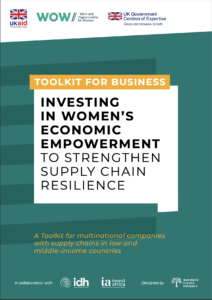Supply chains are under immense pressure — from escalating geopolitical tensions and the impacts of climate change to conflicts and economic instability. Companies must somehow navigate these risks whilst simultaneously driving growth, embracing sustainability, satisfying investor demands and meeting ever-evolving consumer expectations. The introduction of mandatory human rights and environmental due diligence regulations has raised the profile of these risks whilst placing a heavier reporting burden on sustainability, legal and compliance teams. Unsurprisingly, many professionals find themselves overwhelmed, concerned that the increased focus on reporting may divert vital resources away from meaningful, actionable initiatives.

Amid these challenges, investing in women’s economic empowerment is a powerful but often-overlooked strategy for building supply chain resilience and creating positive impact.
Six supply chain risks linked to women’s economic empowerment
By harnessing women’s talents and expertise, companies can better anticipate, reduce, and respond to supply chain disruptions. But women frequently face barriers that limit their economic potential – and both women and business suffer as a result.
Conversely, empowering women boosts supply chain resilience and drives global economic growth. Women are forecast to control 75% of global discretionary spending in the next five years. They also play essential roles in supply chains as workers and business owners, particularly in sectors like garment manufacturing and agriculture. Equal participation in the workforce and in business leadership could add $7 trillion to the economy, while closing the gender gap in entrepreneurship could contribute up to $5 trillion in global GDP.
Based on interviews with companies, gender experts and other stakeholders, WOW’s Toolkit identified six key supply chain risks where the link with women’s economic empowerment is clear:
1. Climate-driven threats to the quantity and quality of supplies
Climate change impacts increasingly test the resilience of supply chains, particularly in the agricultural sector. Due to physiological differences, existing inequalities and gendered social responses to shocks, evidence suggests that women are more vulnerable to the health impacts of climate change, and are more likely to lose out on educational or work opportunities as a result of extreme weather events. Women workers across many industries, for example in garment factories and on mining sites, are vulnerable to the health impacts of climate change including heat stress. Companies can act to reduce these risks and ensure safe working conditions, for example by ensuring women farmers can access programmes for climate adaptation and mitigation and considering the needs of women in health and safety assessments, policies and procedures.
2. Risk of human rights abuses including gender-based violence and harassment (GBVH)
Women are often over-represented in low-paid, precarious and informal employment, which alongside a lack of workplace representation makes them particularly vulnerable to human rights abuses at work, including gender-based violence and harassment (GBVH). GBVH is not only devastating for individual women but also has significant business impacts through increased absenteeism, reduced productivity, and increased legal and reputational risk. To better protect women and avoid these outcomes, companies can apply a gender lens to supply chain human rights and workplace safety policies and practice.
|
Partnering to combat GBVH in tea estates The Women’s Safety Accelerator Fund (WSAF) was launched in 2020 to tackle GBVH in tea supply chains, where most workers are women. Funded by Unilever, IDH, Twinings, Taylors, Tesco, and the Ethical Tea Partnership, WSAF now comprises 73 organisations. It has reached over 350,000 tea workers, raising awareness of their rights, providing financial literacy and leadership training, and improving access to support services. WSAF also strengthens tea estates’ capacity to implement safety standards and redress mechanisms, and fosters public-private cooperation for systemic change. WASF’s holistic approach is demonstrating positive outcomes for women workers and business. A mid-term assessment revealed notable improvements: women’s awareness of complaints mechanisms rose from 17% to 79%, male readiness to support survivors increased from 20% to 85%, and managers’ ability to address GBVH improved by 42%. WSAF also benefits businesses by reducing GBVH-related absenteeism by up to 71% and lowering compliance costs for tea estates. |
3. Lack of diversity in the workforce
Sectors such as mining and construction often have limited participation of women in the workforce, causing companies to miss out on the innovation and improved performance that results from diversity. However, in all sectors, women face multiple barriers to entry and advancement, limiting the pool of skills and perspectives that businesses can access.
|
Supporting women as leaders Endeavour Mining, West Africa’s largest gold producer, is increasing women’s representation across its organisation, particularly in leadership. In 2023, women made up 11% of its total workforce, but 22% of supervisory and technical roles, 34% of management roles, and 44% of its board. Its “Women in Endeavour” programme addresses challenges women face at mine sites, enhances leadership skills, and supports career development. Additionally, Endeavour supports women entrepreneurs in mining communities through local associations. |
To address this, companies can embed gender equality in human resource policies and encourage suppliers to do the same.
4. Lack of diversity amongst suppliers
Diverse supply chains are more resilient. However, women entrepreneurs face challenges accessing finance, business networks, and opportunities, especially in traditionally male-dominated sectors. There is much that companies can do to support women entrepreneurs, including providing access to training and finance, and applying a gender lens to supplier diversity policies.
5. Risk of community opposition and protests interfering with operations
Businesses risk disruption when local communities oppose their operations. In many communities, social norms mean that women lack a voice, resulting in them being excluded from community engagement processes, despite their knowledge, skills and leadership in sustainable resource management and community conflict resolution. To strengthen relationships with communities, companies can ensure women can participate equally in community engagement and solution-planning around resource management.
6. Investor and consumer expectations
Gender-lens investing is on the rise, and women control a growing share of global spending. By failing to prioritise women’s empowerment, businesses risk losing out on investment and customer loyalty. Addressing the other five risks above will go a long way to demonstrating to both investors and customers that companies are committed to women’s economic empowerment in their supply chains. Alongside this, companies can make a public, high-level commitment, develop a Gender Action Plan aligned with key investor requirements, and sign up to initiatives like the Women’s Empowerments Principles. Customers can be brought alongside through campaigns which challenge gender stereotypes and repressive social norms, and through positive portrayals of women in branding and advertising campaigns.
Women’s economic empowerment is a strategic investment
Prioritising women in supply chains will enable more women to increase their incomes, exercise their agency and continue to uplift their families and communities. At the same time, it provides a means for companies to mitigate significant threats to global supply chains and to benefit from the valuable perspectives, knowledge and capabilities of women.
This will leave companies better equipped to navigate the complexities and fragility of today’s global supply chains, meet regulatory and stakeholder expectations, and build a more inclusive and sustainable future for all.
The UK Foreign, Commonwealth and Development Office’s (FCDO) aims to foster women-led growth by improving economic opportunities for women working in global value chains, increasing participation and ensuring dignified, equal and empowering work.








